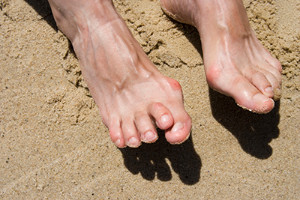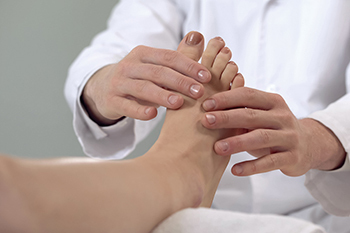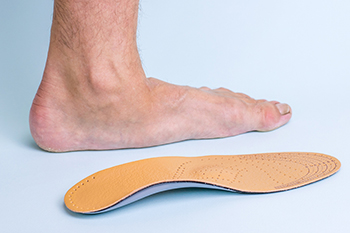Connect With Us
Blog
Items filtered by date: September 2022
Which Toes Does Hammertoe Affect?

The foot condition known as hammertoe is unsightly and it’s considered to be a deformity. Hammertoe affects the middle joints in the second, third, or fourth toes and can cause the toes to bend downward, resembling a hammer. It happens as a result of a muscle imbalance which may occur due to genetic reasons or from wearing shoes that do not have adequate room for the toes to move freely in. The toes look crooked and may be reversed in mild cases. When the toe remains flexible, it may be straightened by pressing on the affected joint. In severe cases, the toes become rigid, and surgery is often necessary for permanent straightening. Some patients develop a hammertoe from stubbing their toe and this can push the tissues at the joint out of alignment. If you have developed a hammertoe, it is suggested that you consult a podiatrist for a proper diagnosis as well as treatment options that are best for you.
Hammertoe
Hammertoes can be a painful condition to live with. For more information, contact one of our podiatrists from Family Foot Care of Long Island. Our doctors will answer any of your foot- and ankle-related questions.
Hammertoe is a foot deformity that affects the joints of the second, third, fourth, or fifth toes of your feet. It is a painful foot condition in which these toes curl and arch up, which can often lead to pain when wearing footwear.
Symptoms
- Pain in the affected toes
- Development of corns or calluses due to friction
- Inflammation
- Redness
- Contracture of the toes
Causes
Genetics – People who are genetically predisposed to hammertoe are often more susceptible
Arthritis – Because arthritis affects the joints in your toes, further deformities stemming from arthritis can occur
Trauma – Direct trauma to the toes could potentially lead to hammertoe
Ill-fitting shoes – Undue pressure on the front of the toes from ill-fitting shoes can potentially lead to the development of hammertoe
Treatment
Orthotics – Custom made inserts can be used to help relieve pressure placed on the toes and therefore relieve some of the pain associated with it
Medications – Oral medications such as anti-inflammatories or NSAIDs could be used to treat the pain and inflammation hammertoes causes. Injections of corticosteroids are also sometimes used
Surgery – In more severe cases where the hammertoes have become more rigid, foot surgery is a potential option
If you have any questions please contact our office located in Port Jefferson Station, NY . We offer the newest diagnostic and treatment technologies for all your foot and ankle needs.
Signs and Symptoms of Peripheral Neuropathy

Neuropathy is nerve damage that can arise from varied causes. Peripheral neuropathy is damage to the peripheral nerves, and it often affects the lower extremities. It can be experienced as numbness, tingling, or sharp pains in the feet. One might have trouble maintaining their balance, muscle spasms, or muscle weakness. The affected area may feel hot. If left untreated, this condition can hinder quality of life. Those with diabetes, HIV, stroke, high blood pressure, and autoimmune diseases are among those most at risk for this affliction. Accidents, infections, or vitamin deficiencies can also lead to nerve damage. Smoking and drinking can lead to a higher incidence of peripheral neuropathy as well. Lifestyle changes, such as in diet and exercise, can slow down or reverse symptoms and the progression of such nerve damage. The earlier peripheral neuropathy is caught, the better the diagnosis. So it is suggested that you consult with a podiatrist as soon as symptoms are felt.
Neuropathy
Neuropathy can be a potentially serious condition, especially if it is left undiagnosed. If you have any concerns that you may be experiencing nerve loss in your feet, consult with one of our podiatrists from Family Foot Care of Long Island. Our doctors will assess your condition and provide you with quality foot and ankle treatment for neuropathy.
What Is Neuropathy?
Neuropathy is a condition that leads to damage to the nerves in the body. Peripheral neuropathy, or neuropathy that affects your peripheral nervous system, usually occurs in the feet. Neuropathy can be triggered by a number of different causes. Such causes include diabetes, infections, cancers, disorders, and toxic substances.
Symptoms of Neuropathy Include:
- Numbness
- Sensation loss
- Prickling and tingling sensations
- Throbbing, freezing, burning pains
- Muscle weakness
Those with diabetes are at serious risk due to being unable to feel an ulcer on their feet. Diabetics usually also suffer from poor blood circulation. This can lead to the wound not healing, infections occurring, and the limb may have to be amputated.
Treatment
To treat neuropathy in the foot, podiatrists will first diagnose the cause of the neuropathy. Figuring out the underlying cause of the neuropathy will allow the podiatrist to prescribe the best treatment, whether it be caused by diabetes, toxic substance exposure, infection, etc. If the nerve has not died, then it’s possible that sensation may be able to return to the foot.
Pain medication may be issued for pain. Electrical nerve stimulation can be used to stimulate nerves. If the neuropathy is caused from pressure on the nerves, then surgery may be necessary.
If you have any questions, please feel free to contact our office located in Port Jefferson Station, NY . We offer the newest diagnostic and treatment technologies for all your foot care needs.
Signs and Symptoms of Peripheral Neuropathy

Neuropathy is nerve damage that can arise from varied causes. Peripheral neuropathy is damage to the peripheral nerves, and it often affects the lower extremities. It can be experienced as numbness, tingling, or sharp pains in the feet. One might have trouble maintaining their balance, muscle spasms, or muscle weakness. The affected area may feel hot. If left untreated, this condition can hinder quality of life. Those with diabetes, HIV, stroke, high blood pressure, and autoimmune diseases are among those most at risk for this affliction. Accidents, infections, or vitamin deficiencies can also lead to nerve damage. Smoking and drinking can lead to a higher incidence of peripheral neuropathy as well. Lifestyle changes, such as in diet and exercise, can slow down or reverse symptoms and the progression of such nerve damage. The earlier peripheral neuropathy is caught, the better the diagnosis. So it is suggested that you consult with a podiatrist as soon as symptoms are felt.
Neuropathy
Neuropathy can be a potentially serious condition, especially if it is left undiagnosed. If you have any concerns that you may be experiencing nerve loss in your feet, consult with one of our podiatrists from Family Foot Care of Long Island. Our doctors will assess your condition and provide you with quality foot and ankle treatment for neuropathy.
What Is Neuropathy?
Neuropathy is a condition that leads to damage to the nerves in the body. Peripheral neuropathy, or neuropathy that affects your peripheral nervous system, usually occurs in the feet. Neuropathy can be triggered by a number of different causes. Such causes include diabetes, infections, cancers, disorders, and toxic substances.
Symptoms of Neuropathy Include:
- Numbness
- Sensation loss
- Prickling and tingling sensations
- Throbbing, freezing, burning pains
- Muscle weakness
Those with diabetes are at serious risk due to being unable to feel an ulcer on their feet. Diabetics usually also suffer from poor blood circulation. This can lead to the wound not healing, infections occurring, and the limb may have to be amputated.
Treatment
To treat neuropathy in the foot, podiatrists will first diagnose the cause of the neuropathy. Figuring out the underlying cause of the neuropathy will allow the podiatrist to prescribe the best treatment, whether it be caused by diabetes, toxic substance exposure, infection, etc. If the nerve has not died, then it’s possible that sensation may be able to return to the foot.
Pain medication may be issued for pain. Electrical nerve stimulation can be used to stimulate nerves. If the neuropathy is caused from pressure on the nerves, then surgery may be necessary.
If you have any questions, please feel free to contact our office located in Port Jefferson Station, NY . We offer the newest diagnostic and treatment technologies for all your foot care needs.
Are Bunions Affecting Your Everyday Life?
Are Bunions Affecting Your Everyday Life?
Flat Feet Can Be Painful

When one has flat feet, there are no (or slight) arches in the feet, and the entire sole appears to touch the ground when one is standing. Flat feet can develop if the arch does not develop normally during childhood, from natural wear and tear, or from an injury. This is a common condition that may be painless or cause the feet to tire easily and feel painful. If this happens, it is because the connecting ligaments and muscles of the foot are strained. The feet might tire easily. Rarely, it will lead to problems with moving the feet. However, even if this condition does not cause foot pain, it can contribute to ankle, knee, and back problems from a change in the leg’s alignment. Some children can develop flexible flat feet, and this is when the arch can be seen when the child stands on tiptoes or sits, but when standing, the arch disappears. Since other conditions can cause similar pain as with flat feet, it is suggested that you visit a podiatrist for a proper diagnosis and treatment.
Flatfoot is a condition many people suffer from. If you have flat feet, contact one of our podiatrists from Family Foot Care of Long Island. Our doctors will treat your foot and ankle needs.
What Are Flat Feet?
Flatfoot is a condition in which the arch of the foot is depressed and the sole of the foot is almost completely in contact with the ground. About 20-30% of the population generally has flat feet because their arches never formed during growth.
Conditions & Problems:
Having flat feet makes it difficult to run or walk because of the stress placed on the ankles.
Alignment – The general alignment of your legs can be disrupted, because the ankles move inward which can cause major discomfort.
Knees – If you have complications with your knees, flat feet can be a contributor to arthritis in that area.
Symptoms
- Pain around the heel or arch area
- Trouble standing on the tip toe
- Swelling around the inside of the ankle
- Flat look to one or both feet
- Having your shoes feel uneven when worn
Treatment
If you are experiencing pain and stress on the foot you may weaken the posterior tibial tendon, which runs around the inside of the ankle.
If you have any questions please feel free to contact our office located in Port Jefferson Station, NY . We offer the newest diagnostic and treatment technologies for all your foot and ankle needs.
Flat Feet Can Be Painful

When one has flat feet, there are no (or slight) arches in the feet, and the entire sole appears to touch the ground when one is standing. Flat feet can develop if the arch does not develop normally during childhood, from natural wear and tear, or from an injury. This is a common condition that may be painless or cause the feet to tire easily and feel painful. If this happens, it is because the connecting ligaments and muscles of the foot are strained. The feet might tire easily. Rarely, it will lead to problems with moving the feet. However, even if this condition does not cause foot pain, it can contribute to ankle, knee, and back problems from a change in the leg’s alignment. Some children can develop flexible flat feet, and this is when the arch can be seen when the child stands on tiptoes or sits, but when standing, the arch disappears. Since other conditions can cause similar pain as with flat feet, it is suggested that you visit a podiatrist for a proper diagnosis and treatment.
Flatfoot is a condition many people suffer from. If you have flat feet, contact one of our podiatrists from Family Foot Care of Long Island. Our doctors will treat your foot and ankle needs.
What Are Flat Feet?
Flatfoot is a condition in which the arch of the foot is depressed and the sole of the foot is almost completely in contact with the ground. About 20-30% of the population generally has flat feet because their arches never formed during growth.
Conditions & Problems:
Having flat feet makes it difficult to run or walk because of the stress placed on the ankles.
Alignment – The general alignment of your legs can be disrupted, because the ankles move inward which can cause major discomfort.
Knees – If you have complications with your knees, flat feet can be a contributor to arthritis in that area.
Symptoms
- Pain around the heel or arch area
- Trouble standing on the tip toe
- Swelling around the inside of the ankle
- Flat look to one or both feet
- Having your shoes feel uneven when worn
Treatment
If you are experiencing pain and stress on the foot you may weaken the posterior tibial tendon, which runs around the inside of the ankle.
If you have any questions please feel free to contact our office located in Port Jefferson Station, NY . We offer the newest diagnostic and treatment technologies for all your foot and ankle needs.
Differences Between Running and Walking Shoes

Running shoes and walking shoes have different purposes and, therefore, are built differently. Running shoes are lighter in weight in order to facilitate speed and feel light on the feet. They also have a stiffer sole, a thicker heel for support and cushioning, and motion control features built in to reduce pronation and unbridled foot motions. Walking shoes provide arch support. They are generally heavier and offer more cushioning, however, heels should not be as thick as running shoes and soles should be more flexible and bendable. A podiatrist can offer additional advice on specific features you should look for in either a running or walking shoe, based on your individual feet, your gait or running stride, and to help address any biomechanical, structural, or alignment issues you may have.
For more information about walking shoes versus running shoes, consult with one of our podiatrists from Family Foot Care of Long Island. Our doctors can measure your feet to determine what your needs are and help you find an appropriate pair of footwear.
Foot Health: The Differences between Walking & Running Shoes
There are great ways to stay in shape: running and walking are two great exercises to a healthy lifestyle. It is important to know that running shoes and walking shoes are not interchangeable. There is a key difference on how the feet hit the ground when someone is running or walking. This is why one should be aware that a shoe is designed differently for each activity.
You may be asking yourself what the real differences are between walking and running shoes and the answers may shock you.
Differences
Walking doesn’t involve as much stress or impact on the feet as running does. However, this doesn’t mean that you should be any less prepared. When you’re walking, you land on your heels and have your foot roll forward. This rolling motion requires additional support to the feet.
Flexibility – Walking shoes are designed to have soft, flexible soles. This allows the walker to push off easily with each step.
If you have any questions, please feel free to contact our office located in Port Jefferson Station, NY . We offer the newest diagnostic and treatment technologies for all your foot care needs.
Differences Between Running and Walking Shoes

Running shoes and walking shoes have different purposes and, therefore, are built differently. Running shoes are lighter in weight in order to facilitate speed and feel light on the feet. They also have a stiffer sole, a thicker heel for support and cushioning, and motion control features built in to reduce pronation and unbridled foot motions. Walking shoes provide arch support. They are generally heavier and offer more cushioning, however, heels should not be as thick as running shoes and soles should be more flexible and bendable. A podiatrist can offer additional advice on specific features you should look for in either a running or walking shoe, based on your individual feet, your gait or running stride, and to help address any biomechanical, structural, or alignment issues you may have.
For more information about walking shoes versus running shoes, consult with one of our podiatrists from Family Foot Care of Long Island. Our doctors can measure your feet to determine what your needs are and help you find an appropriate pair of footwear.
Foot Health: The Differences between Walking & Running Shoes
There are great ways to stay in shape: running and walking are two great exercises to a healthy lifestyle. It is important to know that running shoes and walking shoes are not interchangeable. There is a key difference on how the feet hit the ground when someone is running or walking. This is why one should be aware that a shoe is designed differently for each activity.
You may be asking yourself what the real differences are between walking and running shoes and the answers may shock you.
Differences
Walking doesn’t involve as much stress or impact on the feet as running does. However, this doesn’t mean that you should be any less prepared. When you’re walking, you land on your heels and have your foot roll forward. This rolling motion requires additional support to the feet.
Flexibility – Walking shoes are designed to have soft, flexible soles. This allows the walker to push off easily with each step.
If you have any questions, please feel free to contact our office located in Port Jefferson Station, NY . We offer the newest diagnostic and treatment technologies for all your foot care needs.
Blog Archives
- March 2025
- February 2025
- January 2025
- December 2024
- November 2024
- October 2024
- September 2024
- August 2024
- July 2024
- June 2024
- May 2024
- April 2024
- March 2024
- February 2024
- January 2024
- December 2023
- November 2023
- October 2023
- September 2023
- August 2023
- July 2023
- June 2023
- May 2023
- April 2023
- March 2023
- February 2023
- January 2023
- December 2022
- November 2022
- October 2022
- September 2022
- August 2022
- July 2022
- June 2022
- May 2022
- April 2022
- March 2022
- February 2022
- January 2022
- December 2021
- November 2021
- October 2021
- September 2021
- August 2021
- July 2021
- June 2021
- May 2021
- April 2021
- March 2021
- February 2021
- January 2021
- December 2020
- November 2020
- October 2020
- September 2020
- August 2020
- July 2020
- June 2020
- May 2020
- April 2020
- March 2020
- February 2020
- January 2020
- December 2019
- November 2019
- October 2019
- September 2019
- August 2019
- July 2019
- June 2019
- May 2019
- April 2019
- March 2019
- February 2019
- January 2019
- December 2018
- November 2018
- October 2018
- September 2018
- August 2018
- July 2018
- June 2018
- May 2018
- April 2018
- March 2018
- February 2018
- January 2018
- December 2017
- November 2017
- October 2017
- September 2017

